HP Pavilion 15-cs2000 review – checks all the boxes
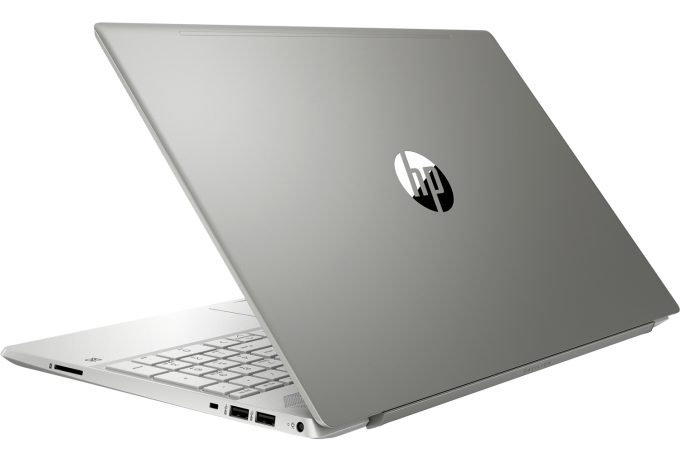 HP Pavilions 15-cs2000 is a pretty good deal. It has a modern design features, layered on top of the familiar Pavilion design. What is more interesting is the fact that it uses a hinge mechanism that rivals the one on the latest ZenBooks and VivoBooks of ASUS.
HP Pavilions 15-cs2000 is a pretty good deal. It has a modern design features, layered on top of the familiar Pavilion design. What is more interesting is the fact that it uses a hinge mechanism that rivals the one on the latest ZenBooks and VivoBooks of ASUS.
It also packs the ultimate low-voltage package – an 8th Generation U-series chip from Intel and an MX250 graphics card from NVIDIA. In addition to that, some models will be sold with the GTX 1050 and GTX 1050 Ti, which are a lot more powerful, but also draw more power than the MX250.
Let’s see if the high expectations set by the IPS panel and the hardware are going to propel the Pavilion 15-cs2000 above the competition, or it will be a sound and shameful defeat.
You can check the prices and configurations in our Specs System: https://laptopmedia.com/series/hp-pavilion-15-15-cs0000-cs1000-cs2000/
Contents
Specs Sheet
- GPU
- NVIDIA GeForce MX130 (2GB GDDR5) #256 in Top GPUs Intel Iris Xe Graphics G7 (96EU) #226 in Top GPUs Intel Iris Plus Graphics G7 #257 in Top GPUs AMD Radeon RX Vega 8 (R2000/3000, 15W) #252 in Top GPUs AMD Radeon RX Vega 7 (R4000/5000, 15W) #242 in Top GPUs AMD Radeon RX Vega 6 (R4000/5000, 15W) #251 in Top GPUsNVIDIA GeForce MX150 (2GB GDDR5) Intel UHD Graphics 620 Intel HD Graphics 610
- HDD/SSD
- up to 8000GB SSD + up to 2000GB HDD
- M.2 Slot
- 1x 2280 M.2 NVMe slot See photo
- RAM
- up to 64GB
- OS
- Windows 10 Home, Windows 11 Home, Windows 10 Pro, Windows 11 Pro, No OS
- Battery
- 41Wh, 3-cell, 41Wh, 4-cell, 41Wh, 3-cell
- Dimensions
- 361 x 245 x 18 mm (14.21" x 9.65" x 0.71")
- Weight
- 1.92 kg (4.2 lbs)
- Ports and connectivity
- 2x USB Type-A
- 3.2 Gen 1 (5 Gbps)
- 1x USB Type-C
- 3.2 Gen 1 (5 Gbps)
- HDMI
- Card reader
- SD, SDHC, SDXC
- Ethernet LAN
- 10, 100, 1000
- Wi-Fi
- 802.11ac
- Bluetooth
- 4.2
- Audio jack
- 3.5 mm combo
- Features
- Fingerprint reader
- optional
- Web camera
- Backlit keyboard
- optional
- Microphone
- Speakers
- Optical drive
- Security Lock slot
All HP Pavilion 15 (15-cs0000, cs1000, cs2000, cw0000, cw1000) configurations
What’s in the box?
This laptop comes in an unimpressive box. On the bright side, the protection is made out of foam, rather than just cardboard pieces. Inside the package of our unit, we found a 65W power adapter.
Design and construction
Similarly to other models at this price tag on the market (as the Aspire 5 (A515-54G) for example), the Pavilion 15-cs2000 has an aluminum lid and plastic body all around. We are keen on seeing more and more devices feature the type of hinge, where the laptops use their lid as leverage to lift the backside of the base to improve cooling and comfort during typing. Measurement-wise, the model has an 18 mm profile and a 1.92 kg weight. Thanks to the thin side bezels, the notebook has a very narrow footprint.
Its lid can be opened with a single hand, which is great for this type of device. On top of the display, you can see an HD camera, flanged by dual-array microphone setup.
At the base of this laptop, you can see a pretty interesting layout. On top, there is the signature grill for the latest Pavilions. It houses the speakers, which means they are firing towards the user. Moreover, they have a Bang and Olufsen branding, which naturally means they are tuned by the company.
Its keyboard (which has the power on/off button moved away from it) has a backlight and a very good layout. Except for the “Up” and “Down” arrow keys, the size and spacing between each key is great. It features a full-sized NumberPad, and the characters on each key are super big – something we saw on the HP Spectre x360 15, as well. Key travel is decent, while the feedback is not the most tactile on the planet.
The size of the aforementioned objects makes the palm-rest area one of the smaller out there. This is also one of the reasons HP has put a narrow, but long touchpad. It has relatively good accuracy, but we’ve definitely seen better.
Let’s turn the laptop upside down and see this ventilation grill. Since the speakers are firing towards the user, this grill is the only cutout you can see on the bottom plate. Additionally, the hot air is exhausted from in between the base and the lid and thanks to the design of the hinge, most of the heat is absorbed directly from the screen, which is not great in terms of longevity.
Ports
As the edge around the base is somewhat chamfered, all of the ports have a weird slope positioning. On the left side, you will find the HDMI and RJ-45 connectors, a USB Type-C 3.1 (Gen. 1) and an Audio Jack. Then on the right, you will see the power plug, two USB Type-A 3.1 (Gen. 1) ports and the SD card reader.
Disassembly, upgrade options and maintenance
Oh no! HP has done it again. Perhaps, the company is running for the best secrecy award or something, because the Pavilion 15-cs2000 is yet another model from this manufacturer that has half of its screws hidden. There are three visible in the user-facing side, while three more are located beneath the back feet. On the bright side, they are of a Phillips-head type.
The Pavilion 15-cs2000’s cooling features two heat pipes, which are relatively thin, to cool both the CPU and the GPU. What makes a good impression is a dual-fan setup, which is combined with a pretty long heat spreader.
On the left side of the battery, you can notice the M.2 PCIe x2 slot, which is placed above the 2.5″ SATA drive. On the other side of the machine, you will find two RAM DIMMs that support up to 16GB of DDR4 memory.
Lastly, there is a 41Wh battery package, which is a little disappointing, given the rest of the hardware.
Display quality
HP Pavilion 15 (15-cs2000) has a Full HD IPS panel with a model number Innolux N156HCE-EN1 (CMN15E8). Its diagonal is 15.6″ (39.62 cm), and the resolution 1920 х 1080 pixels. The screen ratio is 16:9, and we are looking at a pixel density of – 142 ppi, and a pitch of 0.18 х 0.18 mm. The screen turns into Retina when viewed at distance equal to or greater than 60cm (24″) (from this distance one’s eye stops differentiating the separate pixels, and it is normal for looking at a laptop).
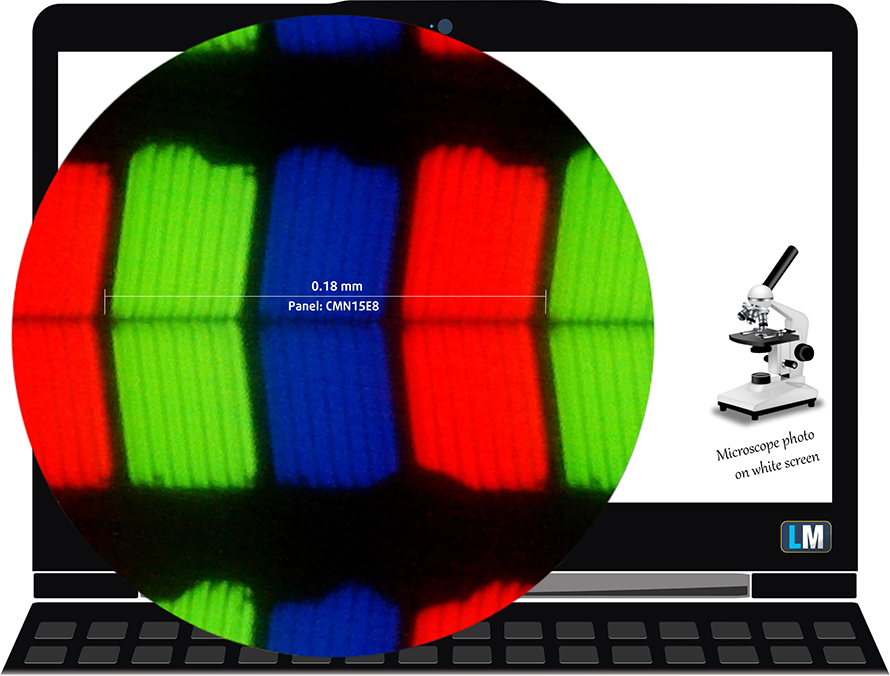
Viewing angles are comfortable. We offer images at 45° to evaluate image quality.

We measured a maximum brightness of 343 nits in the middle of the screen and 308 nits as an average for the whole area, with a maximum deviation of 17% in the bottom left corner. The Correlated Color Temperature on a white screen is 7000K – slightly colder than the optimal for the sRGB standard of 6500K. The average color temperature through the grey scale before profiling is 6840K.
In the illustration below you can see how the display performs from a uniformity perspective. In other words, the leakage of light from the light source.
Values of dE2000 over 4.0 should not occur, and this parameter is one of the first you should check if you intend to use the laptop for color-sensitive work. The contrast ratio is great – 1230:1 (1120:1 after profiling).
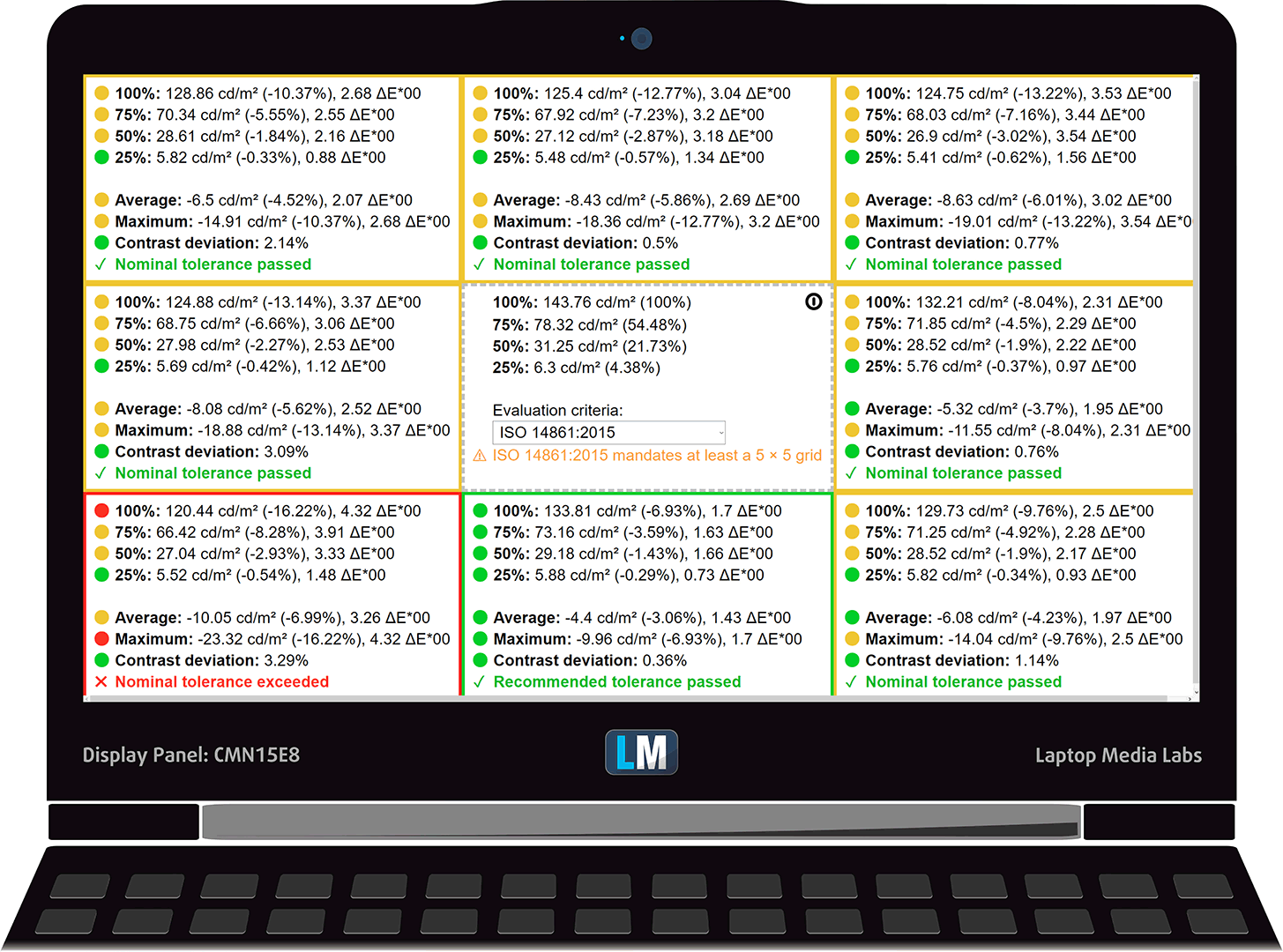
To make sure we are on the same page, we would like to give you a little introduction to the sRGB color gamut and the Adobe RGB. To start, there’s the CIE 1976 Uniform Chromaticity Diagram that represents the visible specter of colors by the human eye, giving you a better perception of the color gamut coverage and the color accuracy.
Inside the black triangle, you will see the standard color gamut (sRGB) that is being used by millions of people in HDTV and on the web. As for the Adobe RGB, this is used in professional cameras, monitors, etc for printing. Basically, colors inside the black triangle are used by everyone and this is the essential part of the color quality and color accuracy of a mainstream notebook.
Still, we’ve included other color spaces like the famous DCI-P3 standard used by movie studios, as well as the digital UHD Rec.2020 standard. Rec.2020, however, is still a thing of the future and it’s difficult for today’s displays to cover that well. We’ve also included the so-called Michael Pointer gamut, or Pointer’s gamut, which represents the colors that naturally occur around us every day.
The yellow dotted line shows HP Pavilion 15 (15-cs2000)’s color gamut coverage.
Its display covers 94% of the sRGB/ITU-R BT.709 (web/HDTV standard) in CIE1976.
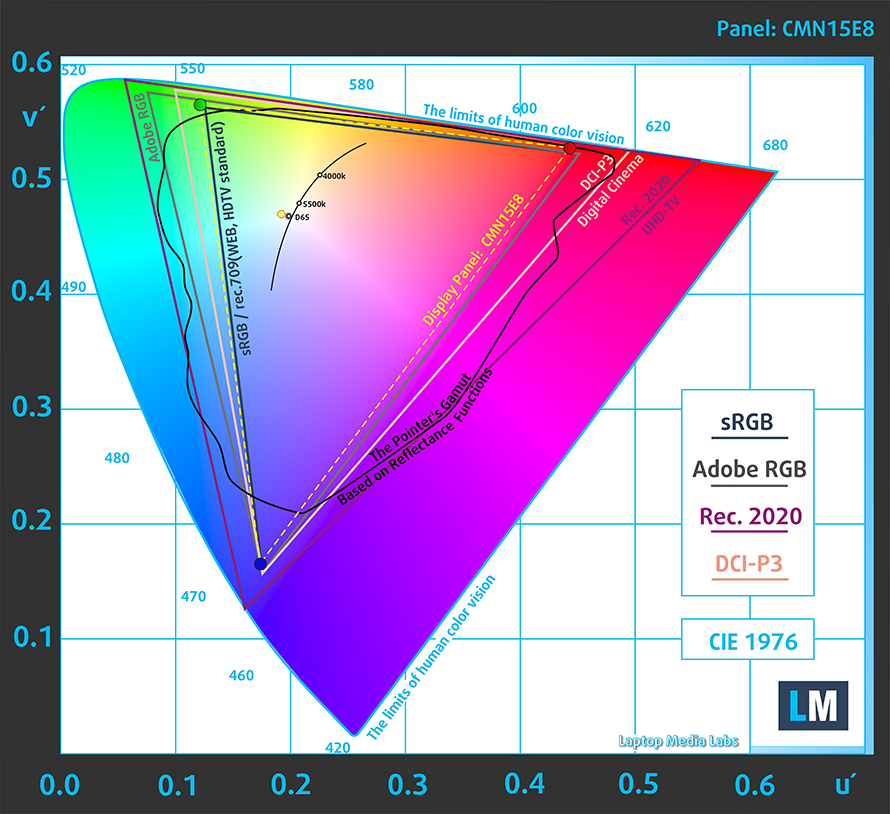
Our “Design and Gaming” profile delivers optimal color temperature (6500K) at 140 cd/m2 luminance and sRGB gamma mode.
We tested the accuracy of the display with 24 commonly used colors like light and dark human skin, blue sky, green grass, orange, etc. You can check out the results at factory condition and also, with the “Design and Gaming” profile.
Below you can compare the scores of HP Pavilion 15 (15-cs2000) with the default settings (left), and with the “Gaming and Web design” profile (right).
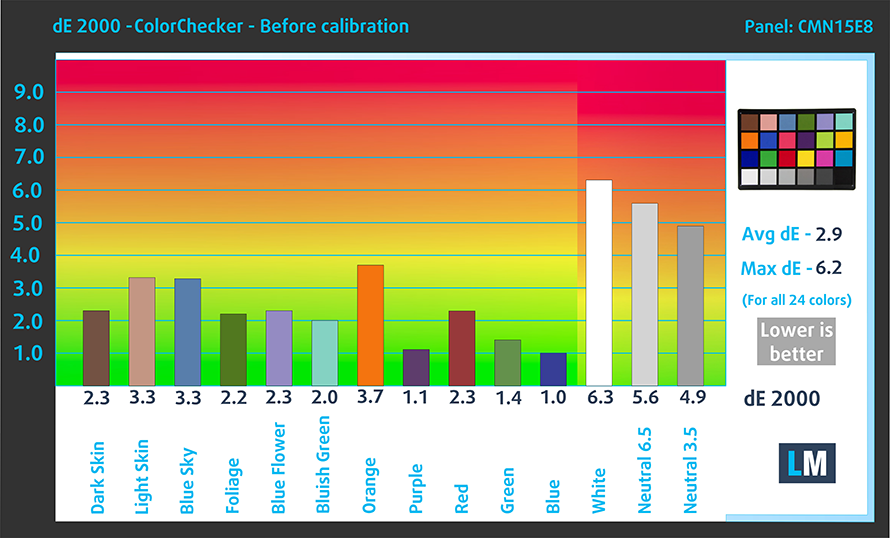
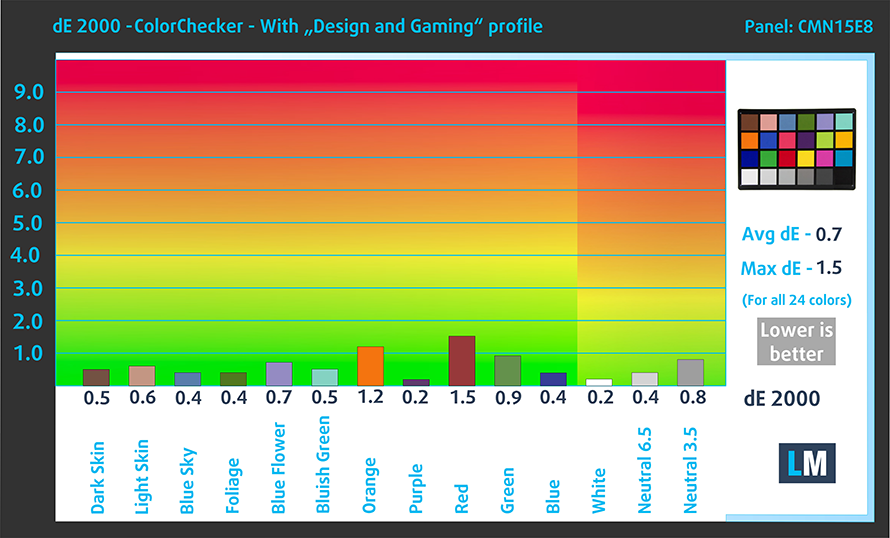
The next figure shows how well the display is able to reproduce really dark parts of an image, which is essential when watching movies or playing games in low ambient light.
The left side of the image represents the display with stock settings, while the right one is with the “Gaming and Web Design” profile activated. On the horizontal axis, you will find the grayscale and on the vertical axis – the luminance of the display. On the two graphs below you can easily check for yourself how your display handles the darkest nuances but keep in mind that this also depends on the settings of your current display, the calibration, the viewing angle, and the surrounding light conditions.

Response time (Gaming capabilities)
We test the reaction time of the pixels with the usual “black-to-white” and “white-to-black” method from 10% to 90% and vice versa.
We recorded Fall Time + Rise Time = 23 ms.
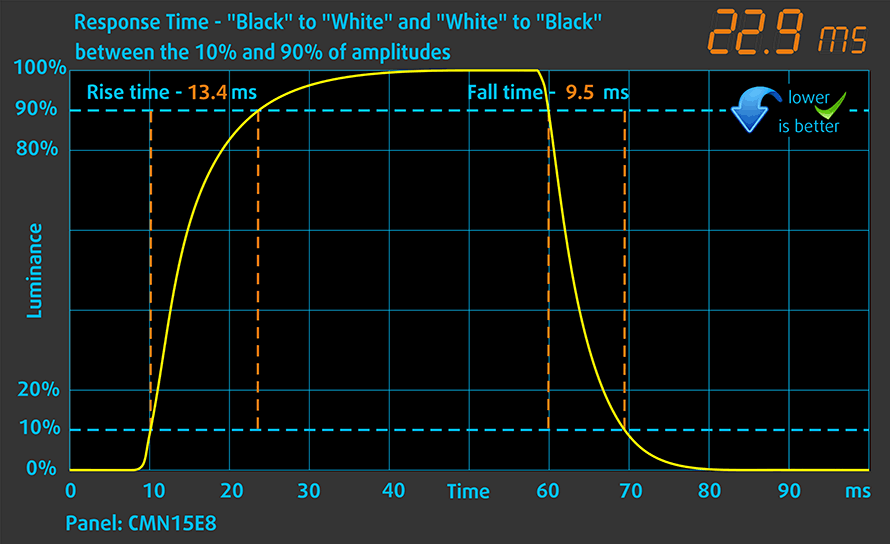
PWM (Screen flickering)
Pulse-width modulation (PWM) is an easy way to control monitor brightness. When you lower the brightness, the light intensity of the backlight is not lowered, but instead turned off and on by the electronics with a frequency indistinguishable to the human eye. In these light impulses, the light/no-light time ratio varies, while brightness remains unchanged, which is harmful to your eyes. You can read more about that in our dedicated article on PWM.
HP Pavilion 15 (15-cs2000)’s display uses PWM to adjust its brightness up until 90 nits. However, the flickering is with a high enough frequency, making it relatively comfortable for extended periods of use, without the excessive strain of the eyes in this aspect.
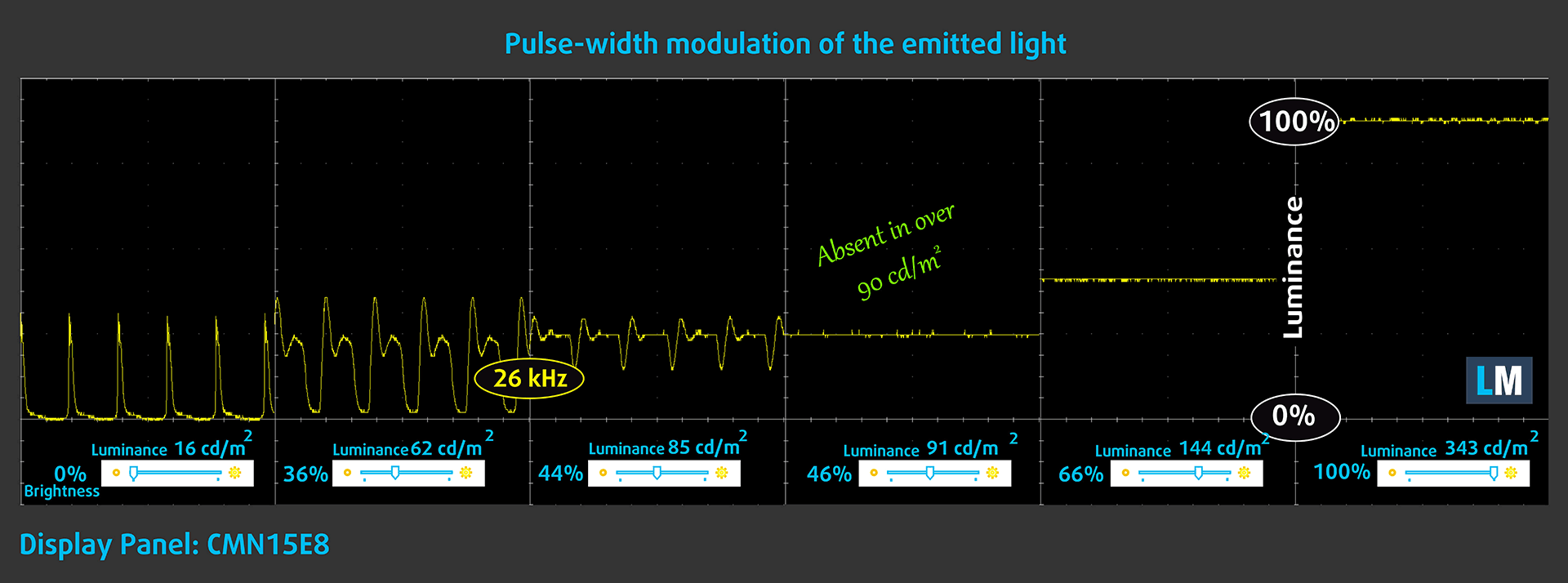
Blue light emissions
Installing our Health-Guard profile not only eliminates PWM but also reduces the harmful Blue Light emissions while keeping the colors of the screen perceptually accurate. If you’re not familiar with the Blue light, the TL;DR version is – emissions that negatively affect your eyes, skin and your whole body. You can find more information about that in our dedicated article on Blue Light.
Conclusion
HP Pavilion 15 (15-cs2000) has an ISP panel with a Full HD resolution, comfortable viewing angles, good contrast ratio and wide color coverage (94% of sRGB). Additionally, its backlight doesn’t flicker above 90 nits, while beneath that value it flickers at a high enough frequency which doesn’t really have an effect on neither your eyes nor brain. What is more impressive about this budget notebook is that it has a very accurate color reproduction. When you apply our Gaming and Web design profiles, it even complies with the Web design standard and is also one of the most accurate displays out there at the moment. Sadly, there is one downside, that cannot be really fixed – it has inappropriate unevenness in the luminance levels at the bottom left corner, compared to the center of the display.
Buy our profiles
Since our profiles are tailored for each individual display model, this article and its respective profile package are meant for HP Pavilion 15 (15-cs2000) configurations with 15.6″ FHD IPS Innolux N156HCE-EN1 (CMN15E8).
*Should you have problems with downloading the purchased file, try using a different browser to open the link you’ll receive via e-mail. If the download target is a .php file instead of an archive, change the file extension to .zip or contact us at [email protected].
Read more about the profiles HERE.
In addition to receiving efficient and health-friendly profiles, by buying LaptopMedia's products you also support the development of our labs, where we test devices in order to produce the most objective reviews possible.

Office Work
Office Work should be used mostly by users who spend most of the time looking at pieces of text, tables or just surfing. This profile aims to deliver better distinctness and clarity by keeping a flat gamma curve (2.20), native color temperature and perceptually accurate colors.

Design and Gaming
This profile is aimed at designers who work with colors professionally, and for games and movies as well. Design and Gaming takes display panels to their limits, making them as accurate as possible in the sRGB IEC61966-2-1 standard for Web and HDTV, at white point D65.

Health-Guard
Health-Guard eliminates the harmful Pulse-Width Modulation (PWM) and reduces the negative Blue Light which affects our eyes and body. Since it’s custom tailored for every panel, it manages to keep the colors perceptually accurate. Health-Guard simulates paper so the pressure on the eyes is greatly reduced.
Get all 3 profiles with 33% discount
Sound
HP Pavilion 15 (15-cs2000)’s speakers produce a loud and clear sond with very good quality in the entire frequency range.
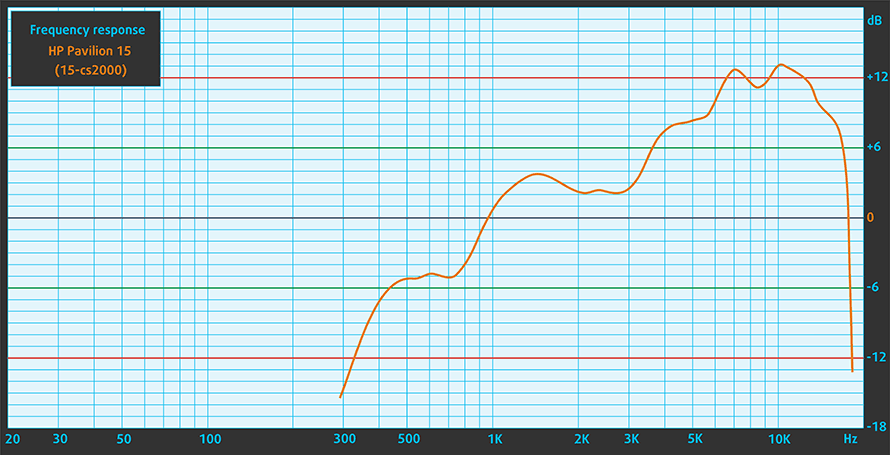
Drivers
All of the drivers and utilities for this laptop can be downloaded from here: https://support.hp.com/us-en/drivers/selfservice/hp-pavilion-15-cs2000-laptop-pc/26122239
Battery
Now, we conduct the battery tests with Windows Better performance setting turned on, screen brightness adjusted to 120 nits and all other programs turned off except for the one we are testing the notebook with. This laptop’s mere 41Wh battery was enough for around 7 hours of Web browsing and 6 hours and a half of video playback.
In order to simulate real-life conditions, we used our own script for automatic web browsing through over 70 websites.
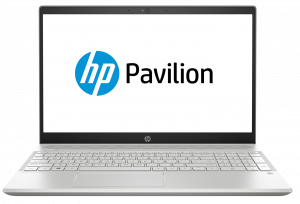
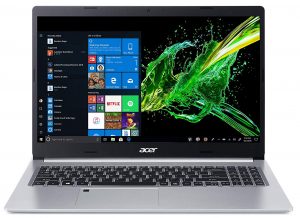
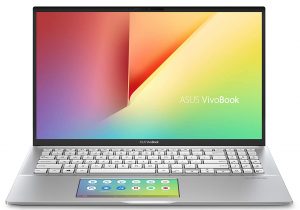
For every test like this, we use the same video in HD.



CPU options
Pavilion 15-cs2000 series come with the 8th Generation Intel ULV processors.
Results are from the Cinebench 20 CPU test (the higher the score, the better)
Results are from our Photoshop benchmark test (the lower the score, the better)
HP Pavilion 15 (15-cs0000, cs1000, cs2000, cw0000, cw1000) CPU variants
Here you can see an approximate comparison between the CPUs that can be found in the HP Pavilion 15 (15-cs0000, cs1000, cs2000, cw0000, cw1000) models on the market. This way you can decide for yourself which HP Pavilion 15 (15-cs0000, cs1000, cs2000, cw0000, cw1000) model is the best bang for your buck.
Note: The chart shows the cheapest different CPU configurations so you should check what the other specifications of these laptops are by clicking on the laptop’s name / CPU.
Results are from the Cinebench 20 CPU test (the higher the score, the better)
Results are from our Photoshop benchmark test (the lower the score, the better)
Results are from the Fritz chess benchmark (the higher the score, the better)
GPU options
Aside from the integrated graphics solutions, HP provides you with the opportunity to get this laptop with a GeForce MX150 or MX250. Some models might feature a GTX 1050 or a GTX 1050 Ti.
Results are from the 3DMark: Time Spy (Graphics) benchmark (higher the score, the better)
Results are from the 3DMark: Fire Strike (Graphics) benchmark (higher the score, the better)
Results are from the Unigine Superposition benchmark (higher the score, the better)
HP Pavilion 15 (15-cs0000, cs1000, cs2000, cw0000, cw1000) GPU variants
Here you can see an approximate comparison between the GPUs that can be found in the HP Pavilion 15 (15-cs0000, cs1000, cs2000, cw0000, cw1000) models on the market. This way you can decide for yourself which HP Pavilion 15 (15-cs0000, cs1000, cs2000, cw0000, cw1000) model is the best bang for your buck.
Note: The chart shows the cheapest different GPU configurations so you should check what the other specifications of these laptops are by clicking on the laptop’s name / GPU.
Results are from the 3DMark: Time Spy (Graphics) benchmark (higher the score, the better)
Results are from the 3DMark: Fire Strike (Graphics) benchmark (higher the score, the better)
Results are from the 3DMark: Wild Life (Graphics) benchmark (higher the score, the better)
Results are from the Unigine Superposition benchmark (higher the score, the better)
Gaming tests

| CS:GO | HD 1080p, Low (Check settings) | HD 1080p, Medium (Check settings) | HD 1080p, MAX (Check settings) |
|---|---|---|---|
| Average FPS | 129 fps | 106 fps | 76 fps |

| DOTA 2 | HD 1080p, Low (Check settings) | HD 1080p, Normal (Check settings) | HD 1080p, High (Check settings) |
|---|---|---|---|
| Average FPS | 94 fps | 74 fps | 62 fps |
Temperatures and comfort
Max CPU load
In this test we use 100% on the CPU cores, monitoring their frequencies and chip temperature. The first column shows a computer’s reaction to a short load (2-10 seconds), the second column simulates a serious task (between 15 and 30 seconds), and the third column is a good indicator of how good the laptop is for long loads such as video rendering.
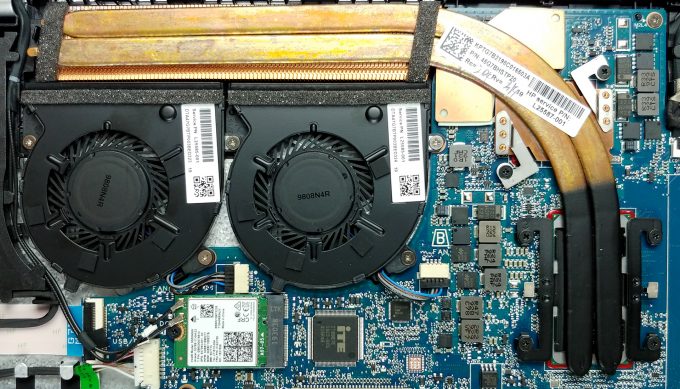
Average core frequency (base frequency + X); CPU temp.
| Intel Core i5-8265U (15W TDP) | 0:02 – 0:10 sec | 0:15 – 0:30 sec | 10:00 – 15:00 min |
|---|---|---|---|
| HP Pavilion 15-cs2000 | 2.79 GHz (B+74%) @ 61°C | 1.88 GHz (B+18%) @ 54°C | 1.93 GHz (B+21%) @ 60°C |
| Lenovo Ideapad S540 (15) | 3.08 GHz (B+93%) @ 72°C | 2.55 GHz (B+59%) @ 72°C | 2.31 GHz (B+44%) @ 71°C |
| Lenovo Ideapad L340 (15″) | 3.27 GHz (B+104%)@ 72°C | 1.99 GHz (B+24%)@ 60°C | 2.01 GHz (B+26%)@ 65°C |
| ASUS VivoBook S15 S532 | 2.96 GHz (B+85%) @ 75°C | 2.95 GHz (B+84%) @ 90°C | 2.17 GHz (B+36%) @ 68°C |
| Lenovo ThinkBook 13s | 2.76 GHz (B+73%)@ 75°C | 2.74 GHz (B+71%)@ 84°C | 2.11 GHz (B+32%)@ 74°C |
| Lenovo ThinkPad T490s | 3.43 GHz (B+114%)@ 91°C | 2.69 GHz (B+68%)@ 91°C | 2.19 GHz (B+37%)@ 80°C |
| HP ProBook 450 G6 | 2.69 GHz (B+59%)@ 64°C | 2.53 GHz (B+60%)@ 68°C | 2.09 GHz (B+31%)@ 71°C |
Despite the intriguing cooling solution, HP has picked a very conservative thermal profile for this laptop. What tells us more about it is the temperature, which is 60C even after 15 minutes of stress testing. We think that this gives plenty of headroom for the graphics card.
Real-life gaming
| NVIDIA GeForce MX250 | GPU frequency/ Core temp (after 2 min) | GPU frequency/ Core temp (after 30 min) |
|---|---|---|
| HP Pavilion 15-cs2000 | 1683 MHz @ 73°C | 1617 MHz @ 74°C |
| Acer Aspire 5 (A515-54G) | 1297 MHz @ 74°C | 1139 MHz @ 74°C |
| Lenovo Ideapad S540 (15) | 1608 MHz @ 69°C | 1404 MHz @ 59°C |
| ASUS VivoBook S15 S532 | 1708 MHz @ 77°C | 1480 MHz @ 67°C |
Apparently, we were right. HP puts all of the cooling efforts when the laptop is gaming. You can clearly hear the fans, although they are not too loud. The result? The highest clocked MX250 after 30 minutes of gaming.
Comfort during full load
The outside of the laptop remains pretty cool after a long period of gaming. However, exactly as we thought, the surface beneath the display is getting the real sauna treatment from the fans, as it reaches 60C at some places.
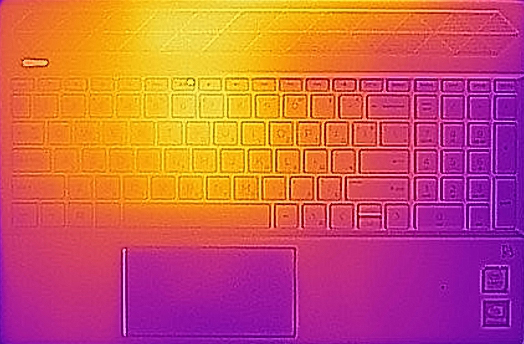
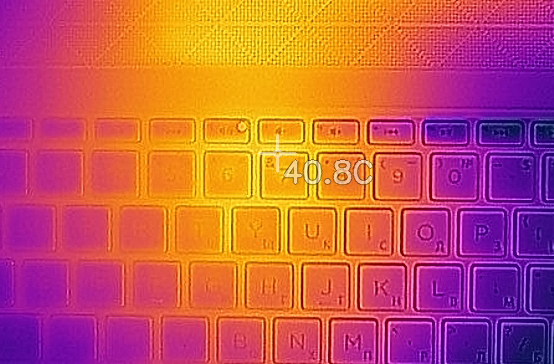
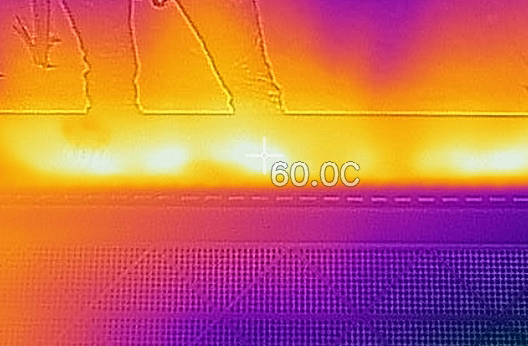
Verdict
 A great all-rounder. The HP Pavilion 15-cs2000 basically has everything you want from such a laptop. On the outside there is a stylish shell with a design, that proves to be flawless. Of course, the most prominent proof comes from ASUS and their ZenBook lineup. We have to note that our unit was equipped with a 1080p IPS panel, which was a good compliment to the 8th Gen Whiskey Lake processors and the MX250 from NVIDIA.
A great all-rounder. The HP Pavilion 15-cs2000 basically has everything you want from such a laptop. On the outside there is a stylish shell with a design, that proves to be flawless. Of course, the most prominent proof comes from ASUS and their ZenBook lineup. We have to note that our unit was equipped with a 1080p IPS panel, which was a good compliment to the 8th Gen Whiskey Lake processors and the MX250 from NVIDIA.
In fact, in our temperature test, we got some interesting results – the CPU is treated conservatively as if it has an Asian father. However, this means that more cooling potential is left for the GPU, which at the end of the day makes the MX250 in this device the highest clocked after a long period of gaming.
However, you have to be fully aware that, despite the dedicated GPU, this is clearly no gaming notebook. You can look at it more like a creator’s type or laptop for photographers (as it has an SD card reader). Moreover, you have the freedom to upgrade your storage and RAM. There is an M.2 slot, which supports PCIe x2 speeds, as well as a 2.5″ drive slot. However, something we see rarely in laptops of this price is two slots of RAM and they support up to 16GB of memory.
HP Pavilion 15 (15-cs2000) has an ISP panel (Innolux N156HCE-EN1 (CMN15E8)) with a Full HD resolution, comfortable viewing angles, good contrast ratio and wide color coverage (94% of sRGB). Additionally, its backlight doesn’t flicker above 90 nits, while beneath that value it flickers at a high enough frequency which doesn’t really have an effect on neither your eyes nor brain. What is more impressive about this budget notebook is that it has a very accurate color reproduction. When you apply our Gaming and Web design profiles, it even complies with the Web design standard and is also one of the most accurate displays out there at the moment. Sadly, there is one downside, that cannot be really fixed – it has inappropriate unevenness in the luminance levels at the bottom left corner, compared to the center of the display.
Sadly, its body is built entirely out of plastic, unlike the Ideapad S540 (15) for example, which has a great feel to the touch. However, if you need the laptop for typing, the keyboard of the Pavilion 15-cs2000 is miles away from the shallow unpleasant Ideapad S540 (15) one.
All-in-all, we would recommend this notebook. If you have more green stuck to your pockets, it’s worth paying a visit to the ZenBook 15 UX534 or the VivoBook S15 S532 from ASUS.
Pros
- Upgradability is on point
- GeForce MX250 and an IPS display at a great price
- Great keyboard
- One of the good gaming performances from an energy-efficient GPU
- Great IPS display with comfortable viewing angles and good contrast ratio (CMN15E8)
- It doesn’t use harmful PWM to adjust brightness levels (CMN15E8)
- Very accurate color representation, especially when our Gaming and Web design profile is applied (CMN15E8)
Cons
- Plasticky body
- Noticeable unevenness in luminosity in the bottom left corner of the display (CMN15E8)
You can check the prices and configurations in our Specs System: https://laptopmedia.com/series/hp-pavilion-15-15-cs0000-cs1000-cs2000/
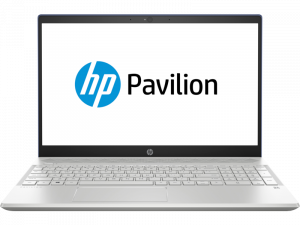
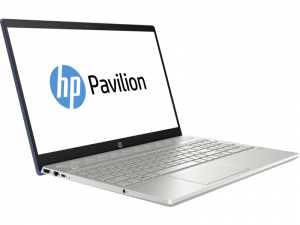
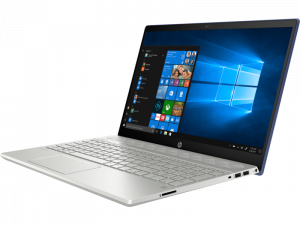
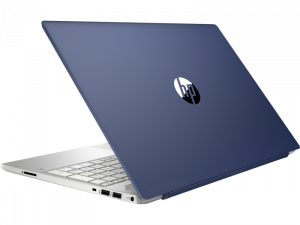

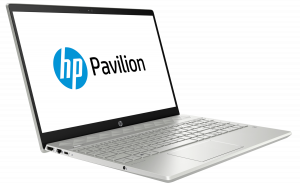
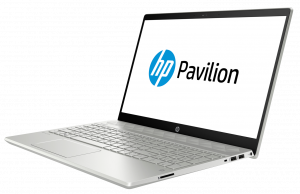
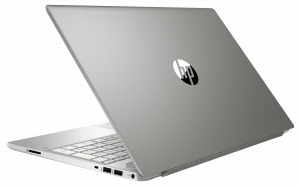

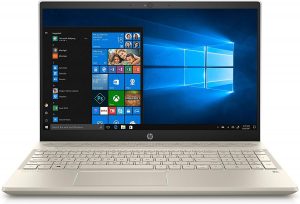
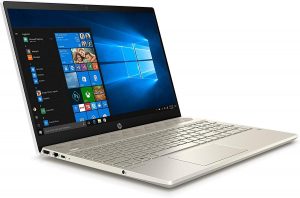
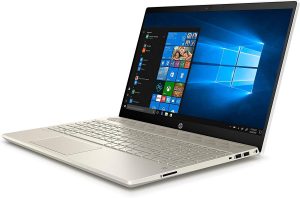
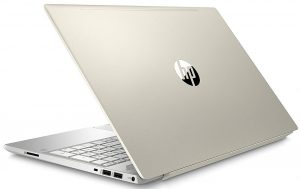

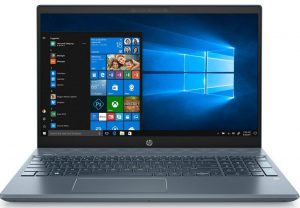
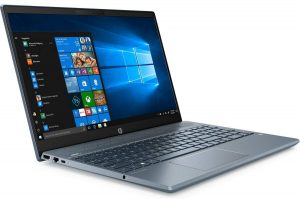

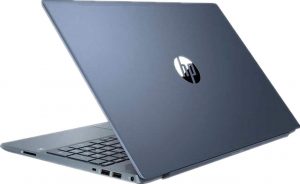

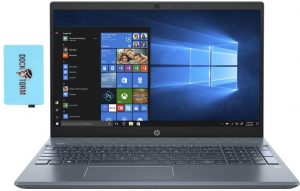

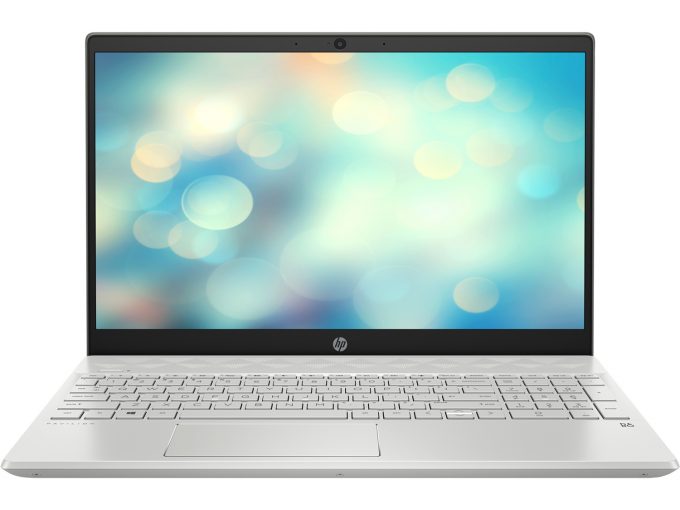
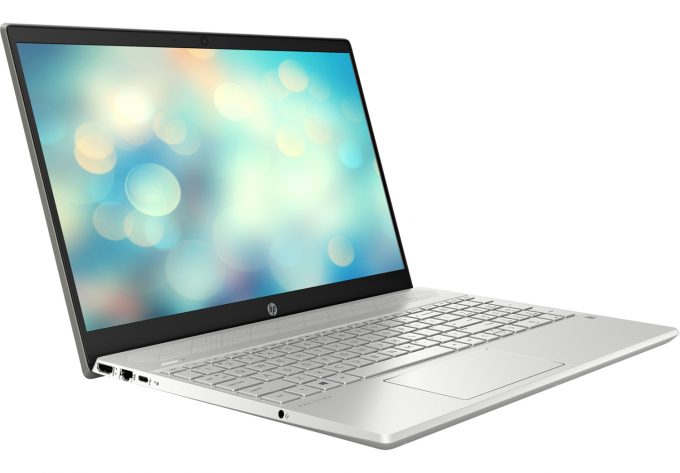



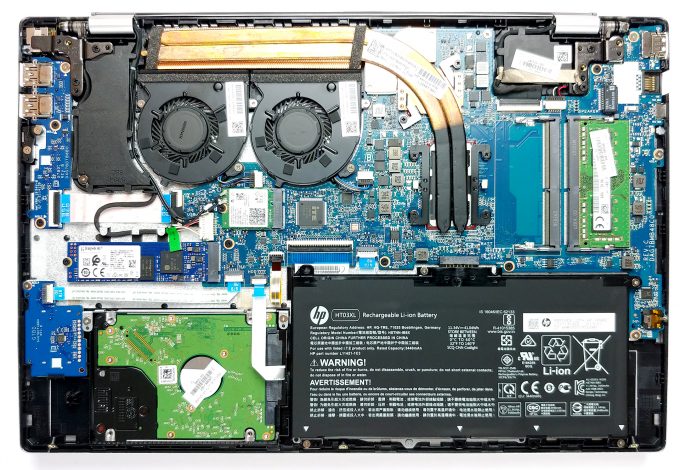
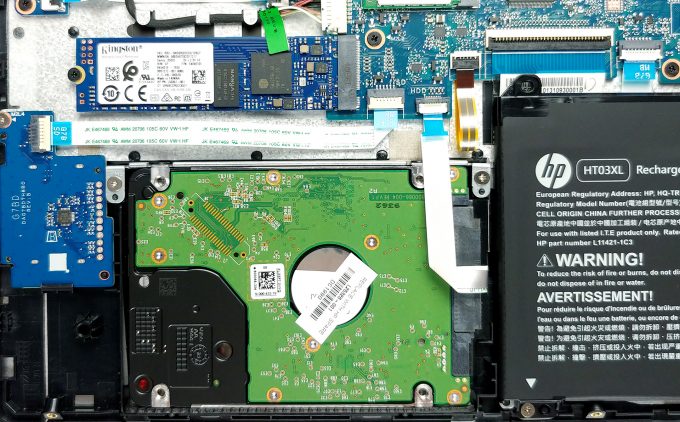
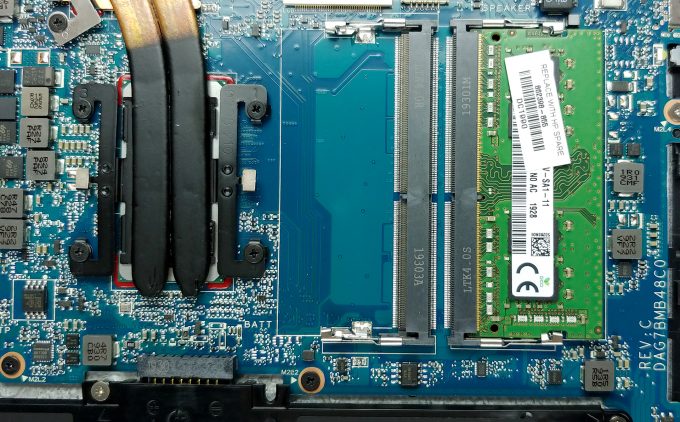
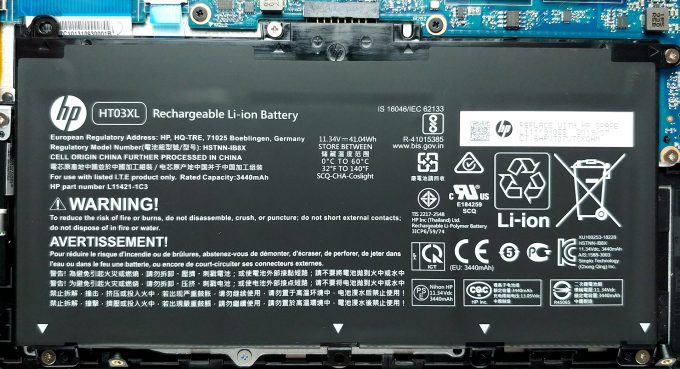

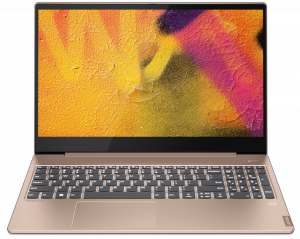
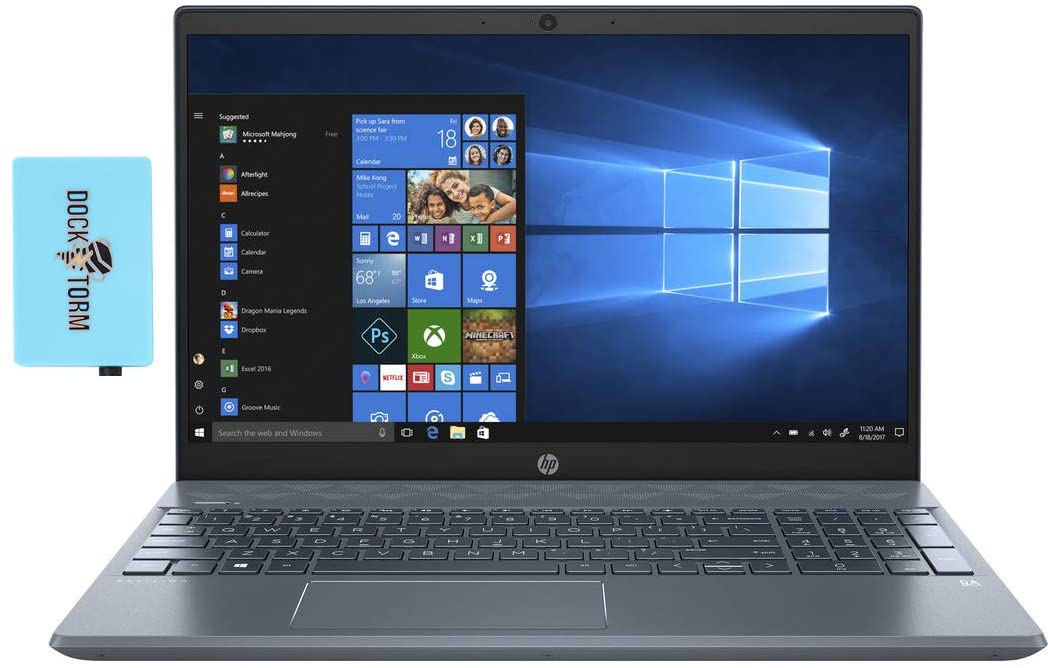








when is display quality coming out. Is there PWM?
Could you please inform us about PWM on this device?
What is the specific model number of the device tested. I am in Canada and the available displays seem to be different.